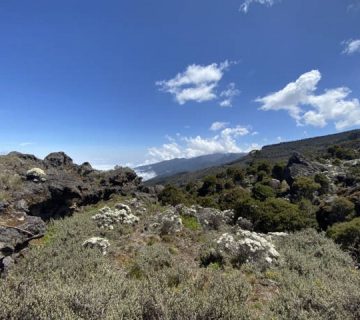Exploring Tanzania’s History On Kilimanjaro Trek
Tanzania, a land draped in cultural tapestries and steeped in ancient lore, invites adventurers and history enthusiasts alike to explore its rich heritage. Among its crowning jewels is Mount Kilimanjaro, not only Africa’s highest peak but also a sentinel to the tales of time. Join us, Kilimanjaro Centre for Trekking and Ecotourism (KCTE), as we embark on a journey that transcends physical boundaries, delving into the heart of Tanzania’s history through the enriching experience of a Kilimanjaro trek.
Why Choose Kilimanjaro for a Historical Expedition?
Mount Kilimanjaro, with its three volcanic cones—Kibo, Mawenzi, and Shira—is more than just a trekker’s paradise. It’s a mosaic of ecological systems, each layer telling a different story of time, ecology, and human endeavor. As you ascend its slopes, you walk the paths once trodden by Chagga warriors, behold vistas once worshiped by ancient tribes, and navigate routes that have been pivotal in scientific research and exploration.
A Walk Through Time
Embarking on a Kilimanjaro trek is like flipping through the pages of a natural history book. From the lush rainforests that cloak its base to the alpine desert and the arctic summit, every habitat on Kilimanjaro tells a story of survival and adaptation. This mountain isn’t just about altitude; it’s about attitude—the spirit of Tanzania itself.
Cultural Riches at Every Step
The slopes of Kilimanjaro are home to the Chagga people, one of Tanzania’s largest ethnic groups. Through our guided treks, you will have the opportunity to interact with local communities, learn about traditional Chagga techniques of farming, and hear folklore that has been passed down through generations. Each of these experiences adds a rich layer to your understanding of Tanzanian culture.
The Role of Kilimanjaro in Tanzanian History
Kilimanjaro has been a silent witness to centuries of change. From pre-colonial trade to the struggle for independence, the mountain has seen it all. Historical events, such as the establishment of German and British colonies and the subsequent battles for control, have all played out within sight of this majestic peak.
Kilimanjaro in the Fight for Independence
The mountain served as a symbol of unity and strength during Tanzania’s quest for independence. It was on these slopes that strategies were devised and rebels gathered, drawing strength from the mountain’s enduring presence. The independence torch was lit at Uhuru Peak in 1961, signifying the end of colonial rule and the beginning of a new era.
Environmental Conservation and Historical Preservation
At KCTE, we are deeply committed to preserving both the natural environment of Kilimanjaro and the rich heritage that surrounds it. Our treks are designed not just to educate but to inspire conservation efforts, ensuring that the historical and cultural narratives of this magnificent mountain are preserved for future generations.
Partnering with Local Communities
Our initiatives include partnering with local communities to promote sustainable practices and eco-tourism. By choosing KCTE for your Kilimanjaro trek, you are directly contributing to these efforts, helping us to maintain the integrity of this historic landmark.
The Trek: What to Expect
A trek to Kilimanjaro is a journey through diverse terrains, each with its unique environmental and historical context. We offer various routes, each with its own story. Whether you choose the Machame route, known as the “Whiskey Route” for its challenging path, or the scenic Marangu route, the “Coca-Cola Route,” you are in for a historical adventure.
Highlights of the Kilimanjaro Trek
-
Day 1-3: Rainforest Zone – Start your trek through the dense, verdant rainforest that once served as a natural fortress, protecting the tribes from invaders.
-
Day 4-5: Heath and Moorland – As you ascend, the landscape changes dramatically. This zone was a historical trading route for the Chagga and Maasai tribes.
-
Day 6-7: Alpine Desert and Summit – The final ascent takes you through a lunar-like landscape, ending at Uhuru Peak. Standing at the summit, you’re literally at the top of Tanzania’s history, viewing the land where past, present, and future merge.
Why Book With Kilimanjaro Centre For Trekking and Ecotourism (KCTE)?
When you choose KCTE, you’re not just booking a trek; you’re immersing yourself in the history of Tanzania with guides who are passionate about their heritage. Our expert guides are trained to provide historical insights and engage you with stories that bring the past alive. Additionally, our commitment to eco-friendly practices ensures that your trek is contributing positively to the preservation of this magnificent mountain.
Join Us on a Journey Through Time
Embark on a trek that’s more than just physical. Explore the rich tapestry of Tanzania’s history, woven into the very fabric of Kilimanjaro. Witness the legacy of ancient tribes, colonial histories, and the indomitable spirit of the Tanzanian people.
Ready to explore the historical wonders of Kilimanjaro? Book your trek with Kilimanjaro Centre for Trekking and Ecotourism (KCTE) today and be part of a continuing story.
FAQs
What is the best time to trek Kilimanjaro?
The best times to trek Kilimanjaro are during the dry seasons: from late June to October and from late December to mid-March.
How fit do I need to be to undertake a Kilimanjaro trek?
A Kilimanjaro trek is physically demanding, and it’s recommended that trekkers prepare through regular fitness routines. However, people of all ages have successfully summited, and our guides ensure you progress at a pace comfortable for you.
What should I pack for a trek?
Essential items include thermal clothing, a sturdy pair of hiking boots, rain gear, sun protection, and a sleeping bag suitable for sub-zero temperatures. A detailed packing list will be provided upon booking.
How long does it take to climb Kilimanjaro?
The trek can take anywhere from 5 to 8 days, depending on the route taken and the pace of ascent.
Embark on an adventure where every step tells a story. Join us at KCTE, where history and nature meet on the majestic slopes of Kilimanjaro.




